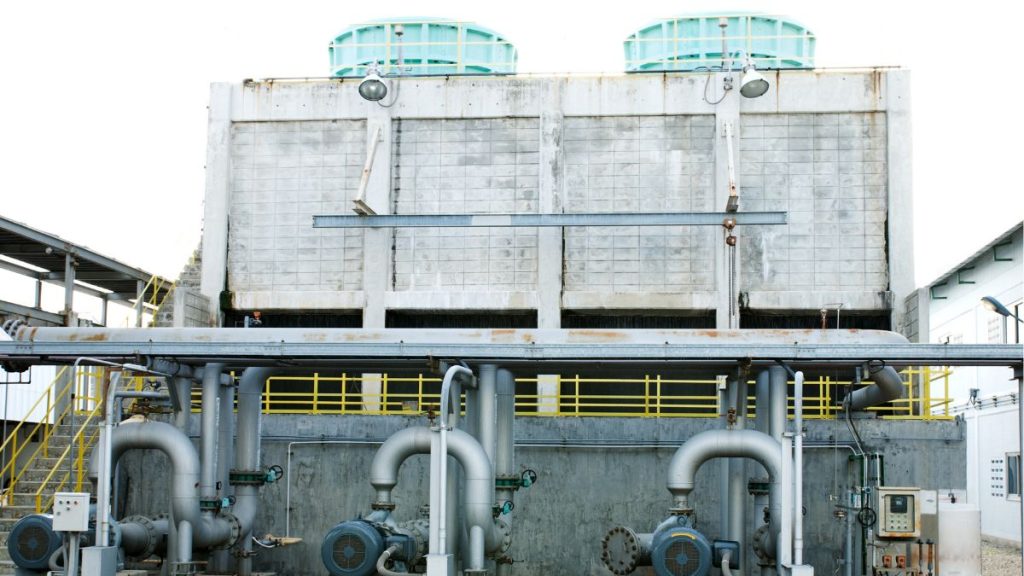Cooling water towers play a crucial role in the cooling process across various industries, from power plants and manufacturing to chemical processing facilities. These systems are designed to remove heat from process air through evaporation before the water is recycled back into the system.
However, during operation, cooling towers often face a number of technical challenges that can compromise efficiency, shorten equipment lifespan, and increase operating costs.
9 Common Cooling Water Tower Problems
Here are some common cooling water tower problems encountered across various industrial sectors, along with their causes and practical solutions.
1. Scaling (Scale Formation)
One of the most common problems encountered in cooling water towers is scaling, or scale formation. Scaling occurs when high levels of minerals such as calcium and magnesium in the air precipitate and form a hard layer on the surface of the heat exchanger or inside the pipes.
This accumulation can impede air flow and reduce heat transfer efficiency, forcing the system to work harder to achieve the same cooling results. This not only increases energy consumption but can also accelerate equipment failure.
To address this issue, it is important to control the quality of the makeup air, use specialized chemicals such as antiscalants, and perform regular blowdowns to reduce mineral concentrations in the system.
Read Also: How to Overcome Increased Hardness in Cooling Systems?
2. Corrosion
Corrosion is also a common cooling water tower problem that can seriously impact system integrity. This process generally occurs due to a chemical reaction between the metals in the system and the air and dissolved oxygen, especially if the air pH is not maintained at an ideal level.
Corrosion causes gradual damage to pipes, pumps, and other metal components, ultimately leading to leaks, system failure, and potential contamination in industrial processes.
To prevent corrosion, strict pH control and the use of appropriate corrosion inhibitors are necessary, which can form a protective layer on metal surfaces.
3. Biological Fouling (Microorganism Growth)
The warm, humid environment of cooling towers is highly conducive to the growth of microorganisms such as algae, bacteria, and fungi. If left unchecked, this microbial growth can form a biofilm on the system’s surfaces, inhibiting heat transfer, clogging flow paths, and producing unpleasant odors.
In extreme cases, the risk of disease caused by Legionella bacteria can even increase. Therefore, biological control is essential in cooling water tower maintenance. Regular use of chemical biocides, both oxidative and non-oxidative, is an important step in keeping the system clean and safe. Furthermore, regular physical cleaning can also help reduce the growth of microorganisms.
Read Also: Why is My Cooling Tower Experiencing Biofouling?
4. Foaming (Foam Formation)
Foaming, or the formation of foam on the surface of coolant tower water, is often a symptom of a chemical imbalance in the system. Foam can form due to chemical overdose, high organic matter content, or excessive microbial activity. Although seemingly trivial, foam can cause air overflow, disrupt system operation, and reduce the effectiveness of the cooling process.
To address this issue, a thorough evaluation of the chemical dosing program and make-up water quality is required, along with the use of antifoam agents when necessary.
5. High Total Dissolved Solids (TDS)
High TDS levels in cool tower water usually occur due to the accumulation of mineral salts due to evaporation. This condition can accelerate scaling, increase the potential for corrosion, and reduce overall system efficiency.
To maintain system stability, TDS monitoring must be performed regularly. Common steps include regular blowdowns to remove mineral-saturated air and the use of pretreatment such as reverse osmosis on make-up water to reduce the mineral load from the start.
6. Uncontrolled pH Fluctuations
pH instability in a cooling water tower system can disrupt the balance of chemical reactions occurring within it. A pH that is too low can accelerate corrosion, while a pH that is too high can encourage scale formation. Both are detrimental.
To prevent this, the system must be equipped with regular pH monitoring and an automatic adjustment mechanism using pH adjuster chemicals such as strong acids or bases, depending on the system’s needs. The use of an automatic dosing system and accurate pH sensors is essential to maintaining system balance.
7. Poor Make-Up Water Quality
Make-up water used to replace water lost through evaporation or blowdown must meet certain quality standards. If make-up water contains high TSS, hardness, or excess organic matter, it will increase the system load and accelerate scaling, fouling, and microbial growth.
Therefore, pretreatment is a key step. Filtration, softening, or reverse osmosis processes can be used to ensure the make-up water meets the operating standards of the cooling tower system.
8. High Amount of Blowdown
Excessively frequent or large-volume blowdown is a significant problem in cooling water tower operations. This condition usually occurs due to ineffective TDS or cycle of concentration control, which requires water with a high mineral content to be continuously removed to prevent system stability.
As a result, make-up water consumption increases, operational costs increase, and chemical use becomes more wasteful. To address this problem, a more precise water control program is required, ranging from optimizing pretreatment, adjusting chemical dosages, to implementing digital monitoring technology.
9. Low Cycle of Concentration
A low cycle of concentration indicates that the cooling tower system is wasting too much water before reaching maximum efficiency. This is often caused by poor make-up water quality or suboptimal blowdown control settings.
A low cycle not only indicates water waste but also indicates that the system is not utilizing the water’s maximum cooling potential. To correct this, a thorough evaluation of the water treatment system, the use of appropriate chemical treatments, and a blowdown reset strategy are necessary to ensure the system operates more economically yet remains effective.
Read Also: Cooling Water Treatment: How It Works, Dangers If Ignored, and Solutions
Professional Support for Optimal Cooling Tower Performance
To help overcome common cooling water tower challenges, Lautan Air Indonesia is ready to be your trusted partner. With over four decades of experience in industrial water treatment, we offer integrated solutions that encompass chemicals, equipment, technical services, and monitoring systems.
We provide a variety of chemical treatments, including antiscalants, corrosion inhibitors, biocides, antifoam agents, and pH adjusters, specifically formulated for cooling tower systems, to maintain performance while controlling operational costs.
For companies seeking more efficient system management, we also provide comprehensive operation & maintenance (O&M) services, including blowdown management, periodic monitoring, and chemical usage optimization.
Want to ensure your cooling tower system is free from common problems and continues to operate optimally? Contact us for a technical consultation, to schedule a field survey, or to learn more about our products and services.



